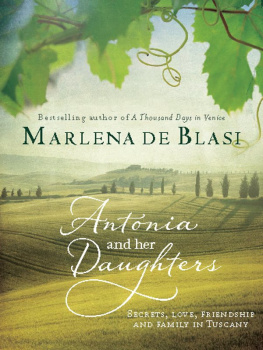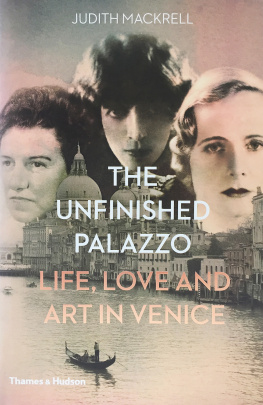Praise for The Lady in the Palazzo
De Blasi doesnt so much observe life as devour it.... Her robust appetite for life saturates the book.
Entertainment Weekly
At the heart of this memoir... is the continuing love story of a later-in-life romance.... Wow!
The Philadelphia Inquirer
Does for Umbria what Frances Mayes did for Tuscany.
Bloomberg.com
Perfect for armchair travelers, foodies, or any reader who loves a romantic story about the joy of discovery in a foreign land.
Pages
[De Blasis] poetic writing style, her meditative internal monologues, her celebration of traditional foods and her inclusion of a number of recipes from the region, make this a feast for armchair travelers, food enthusiasts, romantics and anyone who enjoys a good story with a happy ending.
Rocky Mount (NC) Telegram
De Blasi is a skilled, quirky writer; her prose is by turns reserved, rococo, earthy and, above all, fresh.... Delicious.
Kirkus Reviews, starred
Vivid writing and an affectionate appreciation of the sounds, scenes and flavors of Italy, as well as of the somewhat eccentric Umbrians [de Blasi] meets, will charm lovers of that country.
Publishers Weekly
This is what good armchair travel writing is all about. It engages the reader in the narrative with a strong sense of place and character. By the time the book is finished you will feel as much a part of the Italian community as de Blasi does.
Midwest Book Review
Captivating and affectionate descriptions of the sounds, scenes, and flavors of Italy.
The Cedar Rapids (IA) Gazette
A terrific introduction to a different part of the Italian countryside and population.
The Courier-Gazette (ME)
The reader comes away with an understanding of what lies behind the sumptuous walls and delicate art.
Costa Mesa (CA) Daily Pilot
The Lady in the Palazzo
ALSO BY MARLENA DE BLASI
Regional Foods of Northern Italy
Regional Foods of Southern Italy
A Thousand Days in Venice
A Thousand Days in Tuscany
A Taste of Southern Italy
That Summer in Sicily
The Lady in the Palazzo
AN UMBRIAN LOVE STORY
by Marlena de Blasi

Published by
ALGONQUIN BOOKS OF CHAPEL HILL
Post Office Box 2225
Chapel Hill, North Carolina 27515-2225
a division of
Workman Publishing
225 Varick Street
New York, New York 10014
2007 by Marlena de Blasi. All rights reserved. First paperback edition, Algonquin Books of Chapel Hill, May 2008. Originally published by Algonquin Books of Chapel Hill in January 2007. Printed in the United States of America.
Published simultaneously in Canada by Thomas Allen & Son Limited.
To protect the privacy of friends and neighbors, sometimes names have been changed.
The Library of Congress has cataloged the hardcover edition as follows:
De Blasi, Marlena.
The lady in the palazzo : at home in Umbria / by Marlena de Blasi.1st ed.
p. cm.
ISBN-13: 978-1-56512-473-8 (HC)
1. Orvieto (Italy)Description and travel. 2. Orvieto (Italy)Social life and customs. 3. De Blasi, MarlenaHomes and hauntsItalyOrvieto. I. Title.
DG975.O7D4 2006
945.652dc22 2006045874
ISBN-13: 978-1-56512-610-7 (PB)
10 9 8 7 6 5 4 3 2 1
First Paperback Edition
Per lamore mio, Fernando Filiberto Maria
Il gran bel gentiluomo di Venezia
Per Alberto Romizi
Il gran bel gentiluomo di Perugia
Per Chuck Adams
Il gran bel gentiluomo di Chapel Hill
Per Alberto Bettini
Il gran bel gentiluomo di Savigno
Per Rosalie Siegel
La gran bella donna di Pennington
Per Edna Tromans
Dolcezza con occhi blu
Contents
The Lady in the Palazzo
It was Don Paolos birthday and all the people of the village were gathered in the piazza to celebrate him. The band played, the wine flowed, the children danced, and, as he stood for a moment alone under the pergola, a little girl approached the beloved priest.
But Don Paolo, are you not happy? she asked him.
Of course I am happy, he assured the little girl.
Why, then, arent you crying?
Part One
The Next House
1
A Life Lived Well Moves Backward
The sausages had been roasted in the bakers oven earlier in the day. Now, plumped and crisp and still in their shallow metal pans, they warm over the embers of a charcoal burner, the scent of them rousing hunger and perfuming the piazza. Nearby, on another table, there sits a large kettle over a gas burner filled with what must be gallons and gallons of local red wine. Whole oranges pricked with cloves float about in the purply depths of it, and a woman in a fur hat with a cardigan over her pinafore stands on a stepladder and stirs the wine with a long wooden spoon. Nearly everyone who passes by tells her the same thing: Dont let it boil, Mariuccia. Per carit, non farla bollire. For pitys sake, dont let it boil.
Mariuccia goes jealously about the business of her infusion, all the while talking easily across the piazza to the polenta man, whose copper cauldron, black and battered, hangs, by virtue of a wrought iron stand, over a pile of red-and-white ashes smoldering in a small circle of stones. A long white apron wraps his jeans, and only a U2 T-shirt keeps him against the late-January afternoon, the thin cotton of it straining across his chest as he whips his savory pap with a broomstick, moving it always in the same direction. Stirring polenta counterclockwise is to flirt with calamity. Any Umbrian will assure you of that.
Polenta incatenata stasera, he tells Mariuccia. Polenta in chains tonight. He points to a great bowl of white beans, which hell fold into the cornmeal when its thickened and smooth. Some fanciful eye in one past century or another must have thought that white beans running through the thick yellow pudding looked like a chain. How a thing happened matters less to an Umbrian than that the thing is preserved, and so polenta in chains the dish will always be.
One side of the piazza is enclosed by a stone wall in which there is a low wooden door. Through the door and down half a flight of steep steps is a grotto, a large cave that has been transformed into a village kitchen, complete with generator and lights. A slab of marble resting on trestles serves as a worktable, covered now in a storm of flour. Oil bubbles in two deep pans set over a wood-fired stove. Tonight the kitchen is the scene of the mixing and rolling and frying of bread dough, all of it performed by women upholstered in the local uniform of flowered pinafore and shawl or sweater, accessorized for winter with stocking cap or woolen kerchief. These women live a few meters from the piazza, some of them inside apartments in the palazzi that sit directly on the square. But rather than cook aloneeach one in her own placethey prefer to gather in the cave to prepare for village feasts or to save a windfall of fruit, a bounty of tomatoes, to set their cheeses to age and the wine-washed haunches of their pigs to dry. And one senses that the kitchen serves some other, more sympathetic purpose, as a club or a bar or a card room does for their men. Two of the women enter the kitchen now, sharing the weight of a sack of flour; two others exit, each one holding her half of a wooden wine case filled with just-fried flats of bread.
Next page










